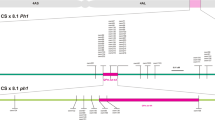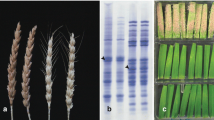Summary
A new source of resistance to wheat powdery mildew caused by Erysiphe graminis has been transferred to hexaploid bread wheat, Triticum aestivum, from the wild tetraploid wheat, Triticum dicoccoides. The donor was crossed to bread wheat and the pentaploid progeny was then self-pollinated. Plants having a near stable hexaploid chromosome complement were selected in the F3 progeny and topcrossing and backcrossing of these to a second wheat cultivar to improve the phenotype was undertaken. Monosomic analysis of early backcross lines showed the transferred gene to be located on chromosome 4A. The gene has been designated Pm16.
Similar content being viewed by others
References
Bennett, F.G.A., 1984. Resistance to powdery mildew in wheat: a review of its use in agriculture and breeding programmes. Plant Pathology 33, pp. 279–300.
Brown, J.K.M., S.E. Slater & P.M. Howe, 1990. Mildew of wheat. U.K. Cereal Pathogen Virulence Survey: 1989 Annual Report, pp. 7–10. N.I.A.B., Cambridge.
Ceoloni, C., G. Del Signori, M. Pasquini & A. Testa, 1988. Transfer of mildew resistance from Triticum longissimum into wheat by Ph1 induced homoeologous recombination. In: T.E. Miller & R.M.D. Koebner (Eds), Proc. 7th Internat. Wheat Genet. Symp., Cambridge, pp. 221–226. I.P.S.R., Cambridge.
Cook, R.J. & J.E. King, 1984. Loss caused by cereal diseases and the economics of fungicidal control. In: R.K.S. Wood & G.J. Jellis (Eds), Plant diseases: infection, damage and loss, pp. 237–245. Blackwell Scientific Publications, Oxford.
McIntosh, R.A., 1988. Catalogue of gene symbols for wheat. In: T.E. Miller & R.M.D. Koebner (Eds), Proc. 7th Internat. Wheat Genet. Symp., Cambridge, pp. 1225–1323. I.P.S.R., Cambridge.
Miller, T.E., S.M. Reader, C.C. Ainsworth & R.W. Summers, 1988. The introduction of a major gene for resistance to powdery mildew of wheat, Erysiphe graminis f.sp. tritici from Aegilops speltoides into wheat, Triticum aestivum. Proc. of the Conference of the Cereal Section of Eucarpia, 1988, pp. 179–183. Pudoc, Wageningen.
Moseman, J.G., R.C.F. Macer & L.W. Greeley, 1965. Genetic studies with cultures of Erysiphe graminis f.sp. hordei virulent on Hordeum spontaneum. Trans. Brit. Mycol. Soc. 48, pp. 479–489.
Priestley, R.H. & R.A. Bayles, 1988. The contribution and value of resistant cultivars to disease control in cereals. In: B.C. Clifford & E. Lester (Eds), Control of plant diseases: Costs and benefits, pp. 53–65. Blackwell Scientific Publications, Oxford.
Sears, E.R., 1954. Aneuploids of Common Wheat. University of Missouri, Columbia, U.S.A., College of Agriculture Research Bulletin 672.
Van Kints, T.M.C., 1987. Mildew of wheat. U.K. Cereal Pathogen Virulence Survey: 1986 Annual Report, pp. 7–14. N.I.A.B., Cambridge.
Wolfe, M.S. & S.E. Wright, 1972. Annual Report of the Plant Breeding Institute, Cambridge, 1971, pp. 142–143.
Author information
Authors and Affiliations
Rights and permissions
About this article
Cite this article
Reader, S.M., Miller, T.E. The introduction into bread wheat of a major gene for resistance to powdery mildew from wild emmer wheat. Euphytica 53, 57–60 (1991). https://doi.org/10.1007/BF00032033
Received:
Accepted:
Issue Date:
DOI: https://doi.org/10.1007/BF00032033




